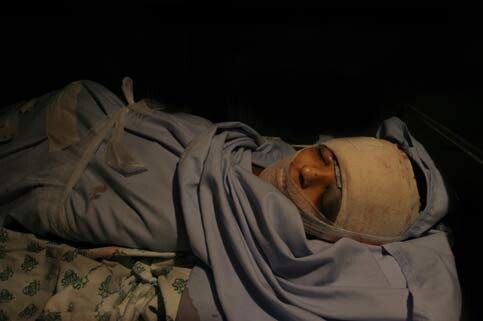B'Tselem 5 August 2006

The body of Khetam Taieh, 11, lies at the morgue of al-Shifa Hospital in Gaza City, 24 July 2006. Khetam was killed in Israeli artillery shelling at a housing project in northern Gaza Strip. (MaanImages/Wesam Saleh)
In July, the Israeli military killed 163 Palestinians in the Gaza Strip, 78 of whom (48 percent) were not taking part in the hostilities when they were killed. Thirty-six of the fatalities were minors, and 20 were women. In the West Bank, 15 Palestinians were killed by Israeli forces in July. The number of Palestinian fatalities in July was the highest in any month since April 2002.
Of the incidents B’Tselem investigated in Gaza over the past month, the organization has identified four cases in which Israel may have committed grave breaches of the laws of war. A total of 15 Palestinian civilians were killed in these incidents, including 7 minors, the details of which are as follows:
On 12 July 2006, a group of youths sought shelter from IDF bombing. Ten of the youths went and hid in a big pit. A missile fired from by an Air Force plane hit the pit, killing six of the youths, five of them minors: Mahmmuad al-‘Asar, Ibrahim a-Nabahin and Ibrahim Qatush, age 15, Ahmad Abu hajaj, age 16. Salah Abu Maktomah, age 17 and Hassan ‘Abeid, age 18.
On 21 July 2006, a few members of the Hararah family went onto the roof of their house in the a-Sheja’iyeh neighborhood in Gaza City to watch tanks advancing toward the neighborhood. One of the tanks fired a shell at the house. It hit the staircase and killed Muhammad Hararah, 45, the brother of the owner of the house. Almost immediately afterwards, another shell was fired at the same spot, killing the mother of the family, Sabah, 45, and two of her sons, Muamen, 16, and ‘Amer, 23.
On 24 July 2006, two youngsters left their family’s farm in the Beit Lahiya area after shells had fallen on the farm’s land. They went by horse-drawn wagon and on the way picked up two of their family. A missile, fired by an Air Force plane, made a direct hit on the wagon, killing Khairieh al-‘Attar, 58 and her grandchild Nadi al-‘Attar, 11. Another member of the family, Shadi, 14 was injured.
IDF tank shell lands next to housing project, killing three civilians.
On 24 July 2006, an IDF fired a shell that fell next to the a-Nada Towers, a housing project located in the northern Gaza Strip. The shelling killed three civilians, one of them a minor: Saleh Naser, 14, Sadeq Naser, 33, and S’adi Na’im, 29.
The IDF did not issue a statement regarding any of these cases, nor acknowledge that these civilians had been killed. It is unclear why, in these four cases, the Israeli military fired at unarmed civilians and at residential apartments. According to B’Tselem’s investigation, there were no armed Palestinians or weapons stored in any of these locations.
Even if the armed forces did not intend to strike civilians, as senior IDF and government officials state repeatedly, B’Tselem’s investigations raise a grave concern that these attacks were launched without taking due caution and without verifying that the targets were not civilian structures, as required by the laws of war.
Furthermore, according to the principle of proportionality, it is forbidden to carry out an attack, even against a military object, with the knowledge that it is liable to cause injury to civilians that is excessive in relation to the military advantage anticipated from the attack. Thus, even if the killing of the 15 civilians in these four incidents resulted from their proximity to armed Palestinians or to weapons, the magnitude of the “collateral” harm to civilians raises the grave concern that the attacks were disproportionate.
B’Tselem has requested the Judge Advocate General to order a Military Police investigation into the circumstances of these cases, and if the suspicions are validated, to prosecute the persons responsible.
Related Links